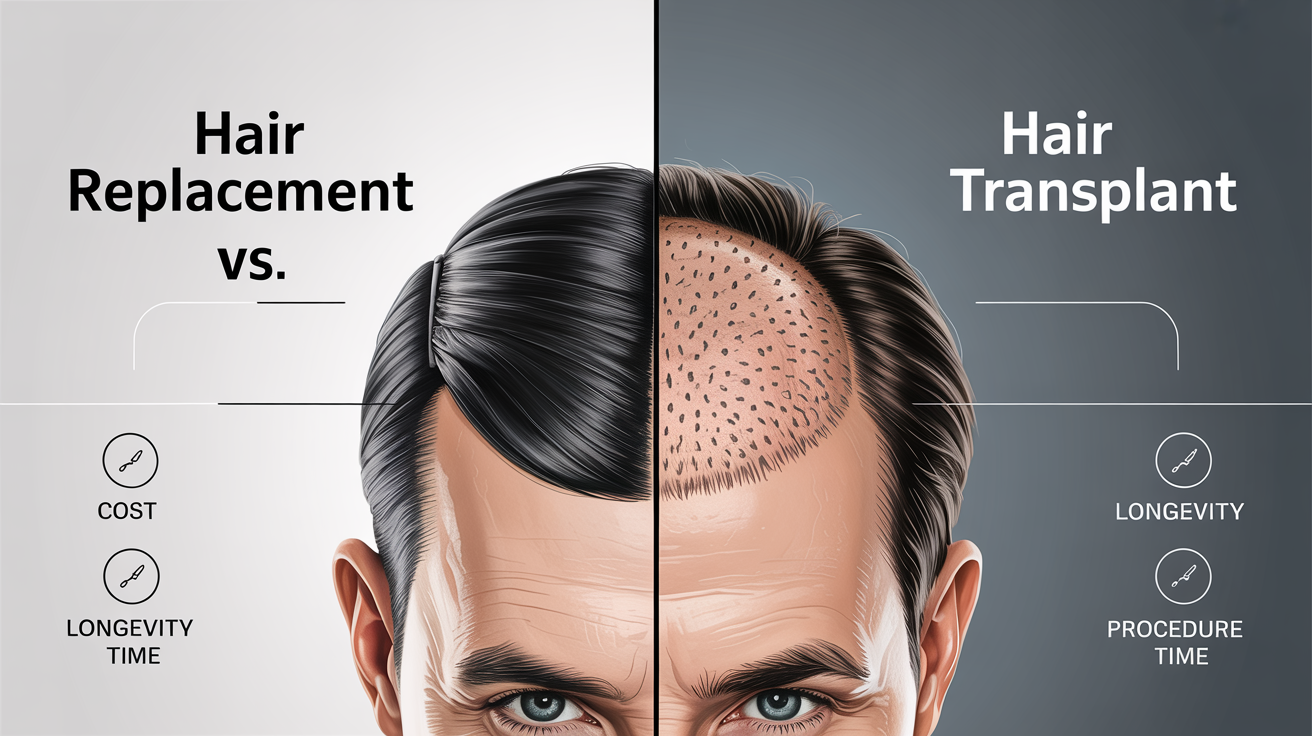Hair Replacement vs. Hair Transplant: Which Is Right for You?
Many people have hair loss, which can hurt their self-esteem, looks, and confidence. Many different treatments are available, but hair replacement systems and hair transplants are two of the most discussed options. Over the years, hair replacement has become very popular since it is non-invasive, affordable, and can deliver results that seem natural quickly.
Even while hair transplants are a permanent medical solution, they aren't right for everyone. Many are concerned about the cost, access to care, recovery time, and side effects. This is where modern hair replacement technologies come in as a safe and useful answer. Let us discuss and conclude whether hair replacement or transplant is right for you.
Benefits of Choosing Hair Replacement Over Traditional Hair Transplants
Modern hair replacement techniques include hair transplantation, which entails surgically transferring hair follicles from thicker parts of the scalp to areas where hair is thinning or completely absent. "Plug grafts," the old method of hair transplantation, didn't seem as realistic. To achieve a more realistic result, modern procedures such as Follicular Unit Transplantation (FUT) (strip method) and Follicular Unit Extraction (FUE) harvest and transplant hair follicles. When medical conditions, injuries, or traumas to the scalp cause hair loss, dermatologists or plastic surgeons may perform a surgical treatment known as a hair transplant.
There are a number of advantages to hair replacement over more conventional hair transplant methods, such as less expense initially, more versatility, and quicker, less invasive results. The process of hair replacement, which is different from surgical transplants, entails securing a hairpiece to the scalp using medical-grade adhesives or clips.
Benefit 1 - Non-Surgical and Minimal Downtime
There are many non-invasive options for hair transplant surgery, such as spinal micropigmentation (SMP), low-level laser therapy (LLLT), platelet-rich plasma (PRP) therapy, glycemic factor (GFC) therapy, wigs and hairpieces, and drugs like finasteride and minoxidil. These options need much less time to recover from. You don't need to take a lot of time off after any operation because it uses your own blood plasma to promote growth, light to stimulate follicles, cosmetic tattooing to make hair look fuller, or real hair additions.
What Makes Hair Replacement Non-Surgical?
Unlike traditional hair transplants, hair restoration does not require cutting the scalp. You may get your full mane back with the newest non-invasive hair restoration technologies, such as bonding procedures, hair systems, wigs, and toppers. This procedure is absolutely painless and safe because it doesn't involve cutting or sewing.
How Minimal Downtime Benefits Your Daily Life
After having hair transplants and taking care of yourself properly, it normally takes a few weeks to feel better. It doesn't take long to get back to your normal activities after getting a hair replacement system. Imagine getting a completely new natural hairstyle in just one session, without having to miss any work or social commitments.
Benefit 2 - Instant Results and Natural Appearance
Hair patches might be a good option for you if you want to fast and naturally replace your hair without having surgery. These hold a personalized hairpiece to the head. Scalp micropigmentation (SMP) is a type of cosmetic tattooing that makes hair look thicker.
How Hair Replacement Provides Immediate Results
The outcomes of hair transplants may not be evident for a few months since the hair follicles that are moved grow slowly. You come in with thin hair and leave with thicker hair. This is the instant satisfaction that hair restoration gives.
Achieving a Natural Look with Hair Replacement Systems
Modern hair systems can now mix in perfectly with your natural hair thanks to new technology. They are designed to match your scalp in every way, like color, texture, density, and tone.
Benefit 3 - No Risk of Scarring or Infection
Scarring and infection are inevitable complications of hair restoration. There is always a small chance of infection with surgical hair transplants, and there is scarring from the incisions made during the procedure. Even with non-invasive methods, side effects, including allergic reactions or skin irritation, are possible.
Why Hair Replacement Is Scarring-Free
It's true that hair replacement surgeries can leave some scars; however, using newer technologies like FUE and better ways to close donor sites, including trichophytic closure, can considerably lessen or get rid of this problem. This is especially true when a good surgeon does the operation. Follicular Unit Extraction (FUE) leaves behind small dot scars, even though newer Follicular Unit Transplantation (FUT) methods can make linear scars very difficult to see, and hair often grows over them. A qualified surgeon, a patient who is recovering, and careful postoperative care are the keys to attaining the best, most undetectable outcomes from both surgeries.
Reduced Risk of Infection with Hair Replacement
To lower the danger of infection after a hair replacement treatment, it is very important to find a reliable facility that maintains stringent sterile standards, keep your personal hygiene in top form, and carefully follow the surgeon's post-operative care instructions. This means not touching your scalp with dirty hands, taking all of your medicine as instructed, and taking care of your wounds appropriately. To further lower the danger of infection from bacteria getting into the small wounds, stay away from intense exercise and keep the area where the transplant took place clean.
Benefit 4—Flexibility and Customization Options
There are several different ways to replace hair, both surgical and non-surgical, that may be customized to fit the person's hair type, density, color, and texture. People have these options to pick from. No other alternative offers as much variety in style, color, and density as non-surgical hair systems do.
Customization Based on Your Desired Look
You can style and color your non-surgical hair replacement system to match your hair, skin tone, and lifestyle for a completely personalized look. To make a custom hairpiece, a hair specialist will evaluate your requirements and obtain exact measurements during the consultation.
Easy to Change Styles and Experiment with Different looks.
Wigs made of real hair, wigs with lace fronts, and hair extensions are the most realistic ways to try out different hair replacement designs. You can cut, paint, and style these parts to make any design you can think of. There aren't nearly as many styles of synthetic wigs as there are of real wigs.
Benefit 5: cost-effectiveness and long-term viability
A hair transplant is the best long-term option for restoring hair because it lasts forever and doesn't need any upkeep. On the other hand, hair patches and medicines are non-surgical alternatives that only work for a short time. Non-surgical options may seem cheaper at first, but the long-term costs of care and replacement may soon become too high.
Comparing the Costs of Hair Replacement vs. Hair Transplants
The initial investment in a hair transplant is typically greater than that of non-surgical alternatives, such as hair systems or patches, because the former is a permanent surgical solution and the latter requires maintenance and replenishment on an ongoing basis. Factors such as the surgeon's skill, the number of grafts needed, the clinic's location, and the technique (FUE vs. FUT) contribute to the overall cost of a transplant. Even if there isn't surgery, the high care and monthly replacement of synthetic hair patches or fibers could make non-surgical options seem like a waste of money.
The Cost-Effectiveness of Hair Replacement Systems
This is because the cost-effectiveness of hair replacement systems depends on whether you choose a non-surgical, temporary option or a more permanent surgical procedure, like a hair transplant. A transplant is a long-term treatment that may save money in the long run, even if it costs more up front and takes longer to recover from. Non-surgical hair systems like wigs and toupees wind up costing more in the long run because of the costs of upkeep, attachment, and replacement. This is still true, even though they are easier for the user and get results faster
Why Hairs Culture is Your Best Choice for Hair Replacement Over Traditional Hair Transplants
We at Hairs Culture are proud to provide new hair replacement options that look good and are made to look natural. Many individuals pick hair replacement over other options since it doesn't require surgery, works quickly, is safe, and helps you completely transform your look.
Look into a solution that is both safe and effective and will boost your confidence straight away. Don't let your hair loss stop you from moving on. Make an appointment with Hair’s Culture to learn about the best hair replacement method for you.
OUR BRANCHES
Abu Dhabi
1402-5A, Al Saman Tower A, Hamdan Bin Mohammed St, 601, Al Danah, Abu Dhabi 22208
Mob: +971502732316
Cochin
3rd Floor, Panorama House, Subash Chandra Bose road, Kadavanthra P.O, Kerala-682020, India
Mob: +919846343333
Calicut
Door # 5/1539 A Krisha Arcade, Jawahar Colony Road, Ashokapuram, Calicut, Kerala-682036, India
Mob: +919745763433
Quilon
1st Floor, Kailash Diabetic Centre, Aanjili Road, Quilon, Kerala-691001, India
Mob: +919846343330
Thrissur
Kingsway Building, C Achutha Menon Rd, Punkunnam, Thrissur, Kerala-680020
Mob: +919846343333
Qatar
Ground floor, Room 02, Ezdan Building # B-1, 4 C Ring Road, Zone:27, Street:230, Baladiya Building:78, Umm Ghuwailina, Doha, Qatar
Mob: +97433195277
68948d2818a72.png)






